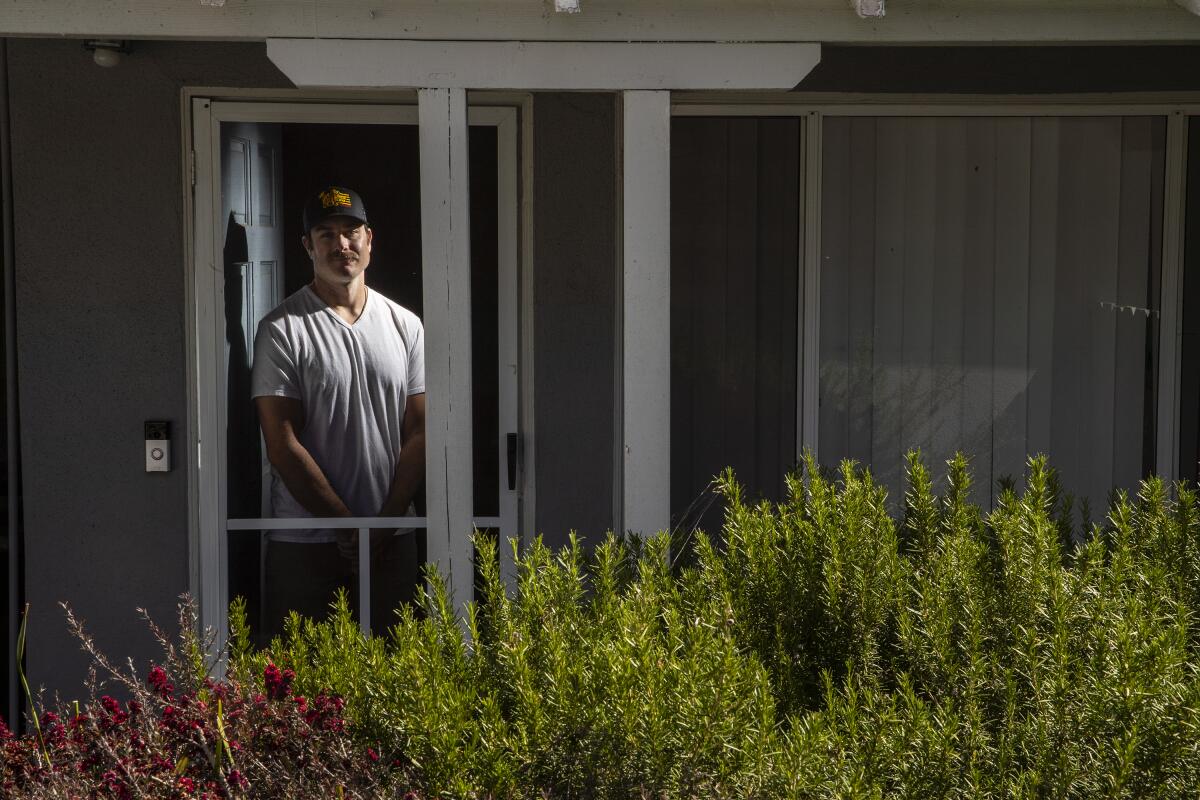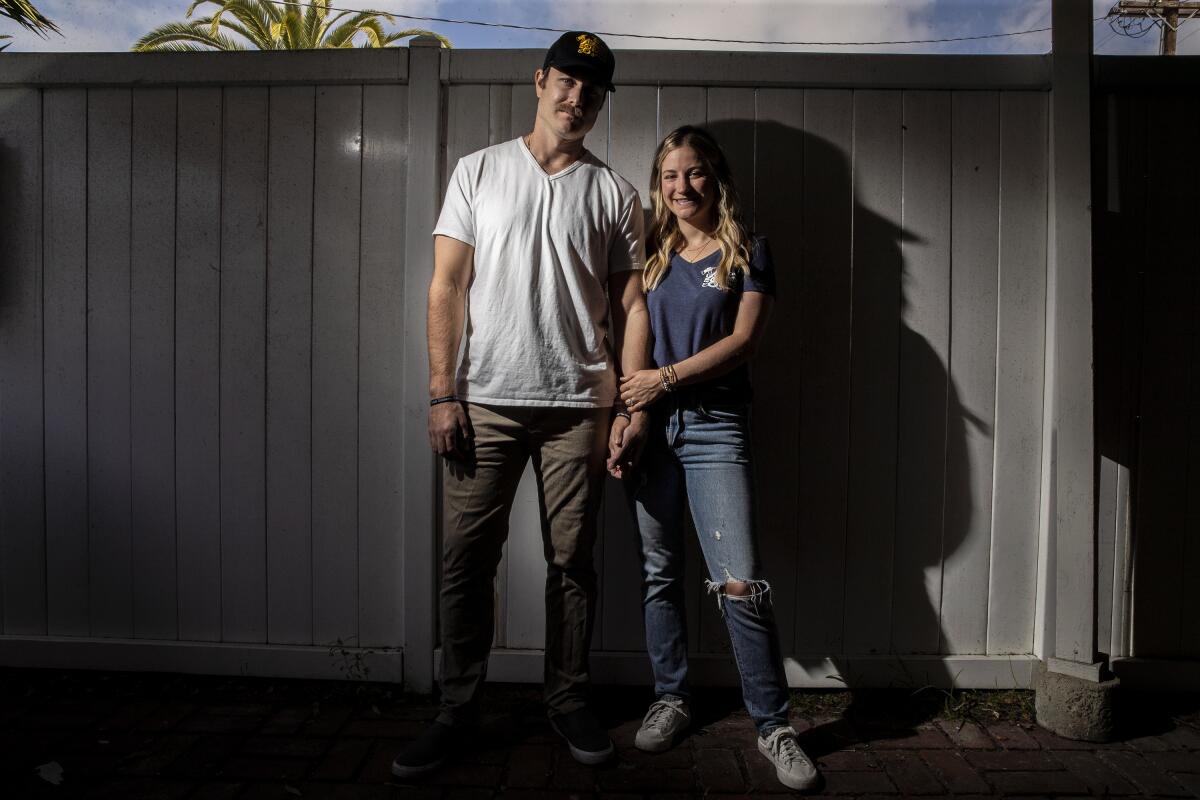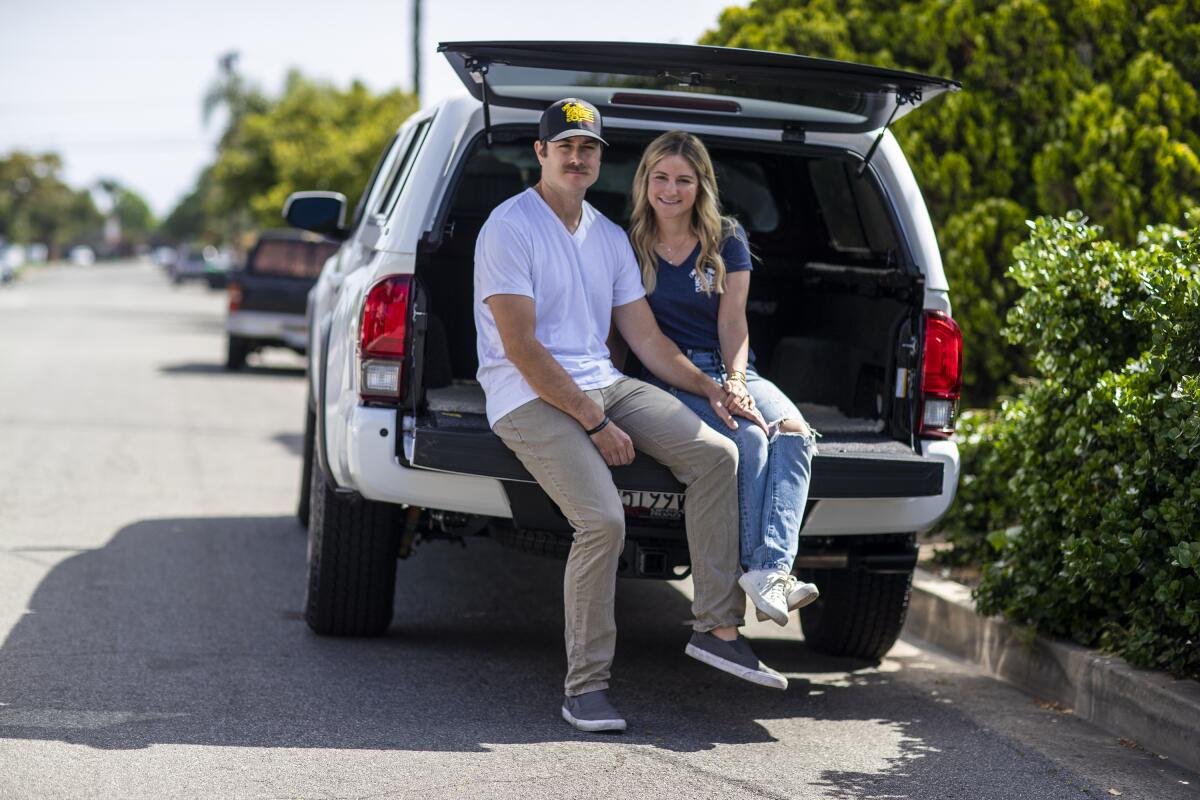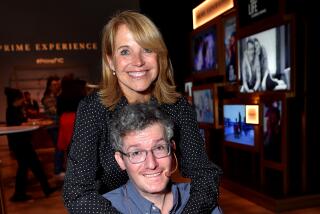Former Rams player turned firefighter fights for hope amid ALS

- Share via
The question returns to Eric Stevens each morning in the hazy seconds after waking up.
“Is this really happening? Do I have ALS?”
The answer is always the same. Amyotrophic lateral sclerosis, also known as Lou Gehrig’s disease, hasn’t left. He hauls himself out of bed at his Costa Mesa apartment and takes the first halting steps of another day without a way to slow the disease that’s consuming his body.
Stevens used to make so many things look easy. He raced BMX bicycles and played hockey and wrestled at Palos Verdes Peninsula High. He surfed Haggerty’s break off Malaga Cove. He fly-fished. He captained the University of California-Berkeley football team, spent part of a season with the St. Louis Rams, joined the Los Angeles Fire Department as a firefighter and, last year before the diagnosis upended everything, married his college sweetheart.
He is 30, and his time is running out. His balance is failing. Breathing is more difficult. His words are thick and labored. Muscles spasm nonstop. His hands cramp when he grabs an object. Simple tasks like closing the tailgate of his pickup truck or doing pushups challenge him.
“Every little thing you do is hard,” Stevens said. “I feel like there’s a 30-pound trenchcoat of water on me. Just heavy. It’s like I’m walking in quicksand.”
He downs more than 20 vitamins and supplements each morning. He drinks celery juice. He relaxes in a donated sauna. He tries to swim laps and walks the neighborhood and does Pilates three times each week. He lifts light weights and exercises with resistance bands. He pushes to raise awareness of ALS and fast-track experimental treatments. He fights to stay positive but can’t escape what his body says. The disease steals a little more each day.
::
Playing fullback for Cal almost a decade ago, Stevens took a handoff early in a game against UCLA. He bounced off one defender, then another and another. The situation looked impossible, but he wouldn’t stop fighting to move forward. He bowled ahead, a 240-pound battering ram breaking five tackles to gain a handful of yards. This was the relentless approach — hurdling opponents or delivering big hits on special teams — that made him a favorite among coaches and teammates.
“Off the field, he’s mild-mannered, extremely bright,” said Ron Gould, who coached running backs at Cal. “On the field, he’ll eat your heart out. He’s a Tasmanian devil. He didn’t back down from anybody.”
Stevens is the youngest of four brothers. The middle two became firefighters. The oldest, Craig, spent eight seasons in the NFL with the Tennessee Titans. Jeff Fisher, who coached the team, remembered Craig as a “muscled-up badass, freakin’ hard-working, smart tight end.”
Fisher, who moved on to join the Rams as coach, didn’t hesitate to sign Eric Stevens as an undrafted free agent in 2013. “That was a no-brainer,” Fisher said. “If this is a Stevens, I’m going to bring this kid to camp.”
The toll of years of football-related injuries, including several concussions, ended his career before appearing in a regular-season game. Besides, he wanted to help people. The next step was obvious. He followed the path of his brothers Brett and Jeff and became a firefighter.
::
In March 2019, Eric Stevens noticed he was tiring easily. His left hand felt weak. The fingers didn’t seem to work the way they should. He dropped tools. His left hand slipped off the bar when doing pull-ups. The routine task of deploying ladders with the Los Angeles Fire Department was no longer routine.
He first mentioned the odd problems to Brett while they surfed in Orange County. They joked about not being as limber as their younger days. But the hand didn’t improve. Eric brought it up whenever they saw each other.
One day while working out before Eric’s wedding in July, the man who once was Cal football’s senior lifter of the year and bench pressed 225 pounds 25 times while auditioning for NFL teams could barely raise a dumbbell over his head. The brothers were always competitive. Brett thought he was finally gaining an edge.
Eric’s speech slowed, he struggled to pronounce words and sometimes slurred them. His muscles twitched. The movement continued day or night, waking or sleeping.
“He didn’t want to go see a doctor about it in fear of what the reality actually was,” Brett Stevens said. “He wasn’t ready to face that. He didn’t want people to worry about him before the wedding.”
Eric scoured the internet for answers. Each symptom matched ALS. The motor neuron disease affects an estimated two out of every 100,000 people, typically striking between ages 40 and 70. The average age of onset is 55.
Eric told himself he was in great shape. He ate right. He was helping people while working at LAFD’s Station 21 in South L.A. He was about to marry former Cal soccer player Amanda Glass. He was just 29. The internet self-diagnosis couldn’t be real.

Brett cautioned against jumping to the worst-case scenario. Maybe an old football injury or pinched nerve lurked behind the symptoms.
Nothing seemed wrong when Eric and Amanda married on a cloudless day in San Luis Obispo on July 27. Former Cal quarterback Beau Sweeney performed the ceremony.
“She is so excited,” Sweeney told the family and friends assembled in front of a white barn, “to start a family one day and can’t wait to watch Eric become an amazing father.”
Three words on the candle label next to the cake summed up the speeches and toasts and smiles: “Happily ever after.”
::
The couple waited in a neurologist’s office after Eric underwent a battery of tests one month after their wedding. They had honeymooned in Montana, watching bison, fly-fishing the Blackfoot River, riding horses and discussing saving for a house. But they couldn’t ignore the symptoms any longer.
The doctor pecked at his computer without speaking for what felt like a half-hour, then finally turned to them and said he believed Eric had ALS. There wasn’t any treatment. The average life expectancy was two to five years. Paralysis usually came sooner.
The color drained from Eric’s face. He almost passed out. Amanda caught him.
“These past few weeks have been absolutely devastating for our family, but we have chosen to FIGHT and if you know Eric you know he will fight HARD,” Amanda later wrote on Facebook. “He is the strongest man I know and if anyone can get through this, it’s him. I know that he will never give up, but I also know that we will need help.”
They sought a second opinion in L.A., then a third in Boston. Both reached the same conclusion.
“You’re just searching for a different answer, a plan or a protocol to slow it down and there’s nothing,” Eric said. “Everything in my life has been so regimented. Here’s the game plan. This is how we’re going to fix it or how we’re going to approach it. Here are the steps to do it. With this, there’s nothing. You’re on your own.”
At least nine other former NFL players are currently living with ALS. They range in age from 36 to 70, though most are in their mid-50s. Among them is Steve Gleason, the former New Orleans Saints standout whose fight against the disease was chronicled in the 2016 documentary “Gleason” and who earned a Congressional Gold Medal. He uses a feeding tube and breathes with the aid of a ventilator, living in the “glass coffin” that some patients call the disease that slowly robs their ability to walk, speak, swallow and move.
“It’s absolutely illogical,” Gleason tweeted earlier this month. “My physical body is totally useless, yet in this moment I’m completely free. Senseless liberation.”
The total number of NFL players, living or dead, with ALS isn’t known. But the settlement to concussion litigation between more than 20,000 former players and the league provides a hint. The most recent data from the agreement shows 56 players or their estates applied for compensation for ALS — 39 have been approved, 14 are being reviewed for compliance with the agreement’s statute of limitations and three have been denied. The demographics of those claims, including how many of them are living, aren’t public.
“It’s such a horrific disease because they tend to be mentally clear until they’re very, very deep into it because they have this progressive inability to move which makes it very tough to watch and take care of,” said Dr. Ann McKee, chief of neuropathology for the VA Boston Healthcare System and director of the Boston University CTE Center, whose research includes ALS.
Some researchers have suggested that repeated brain trauma like the kind experienced by NFL players increases the risk of ALS.
“At first you’re like, ‘What the heck? Was it football that did this?’” Eric said. “No one really has a solid idea. You can’t blame football. Could it have maybe increased my chances of getting it? Maybe. But was it the sole factor? If I didn’t play football would I not have this? I don’t think so.”
::
The couple searched for a treatment, a solution, a prayer.
Just four drugs have been approved by the Food and Drug Administration to treat ALS symptoms, according to the nonprofit ALS Association. Two of the drugs might slow the disease’s progression. There is nothing to stop it, nothing to reverse it, nothing to cure it.
When one of their doctors mentioned ongoing clinical trials for ALS treatments last year, the couple’s excitement vanished when they learned about the byzantine process that governs study and approval of such medications. The disease doesn’t work on the same timeline.
Along with friends and family, they poured their energy into raising awareness about ALS and lobbying to remove bureaucratic obstacles to terminally ill patients trying experimental therapies.
“We’re not just fighting for him, we’re fighting for this whole community that’s become our new family,” said Amanda, who quit her job as a second-grade teacher to care for Eric. “No one really understands the feeling of your body failing on you and shutting down and not being able to do anything about it. I’m seeing it happen to him. … We have an opportunity here to really make noise and hopefully create some change.”

They started the #AxeALS hashtag. Scores of fire departments around the world posted pictures on social media of them posing with the words. They’ve raised more than $900,000 on a GoFundMe. They made videos. They attended fundraisers. They visited a dozen members of Congress in November to share their story and plead for help to fight the disease.
“Eric is extremely tired and progressing at what we think is a faster rate,” Craig Stevens wrote after the trip. “He should be home resting right now, but we all know Eric is a fighter, and that is why he is working so hard to make a change.”
The novel coronavirus redoubled their efforts. Eric and Amanda rarely venture out in public to reduce the chance of Eric contracting the illness. Friends and family members drop groceries on their porch. The couple watches regulations be waived or streamlined to address the pandemic and wonder why a similar approach isn’t taken to help the estimated 16,000 people suffering from ALS in the U.S.
“People have told us over and over again that it’s not possible, we can’t do that, it’s out of our hands, and with COVID-19 we see that anything’s possible,” Eric said. “They’ve moved mountains. I mean, as bad as COVID-19 is, the death rate is less than 10%. With ALS, it’s 100%. … When you’re diagnosed with ALS today, they kind of write you off as a loss because these trial processes take so long. Why not let these people try, right? We know what’s going to happen if we don’t try it, and that’s death.”
There is an urgency to the words and, really, everything the couple does these days. He dropped from 225 pounds to 190 pounds in the last six months as muscles slowly atrophy.
He tries not to think about the disease’s cruel progression, about what he’s lost, about no longer being able to perform basic tasks like tying flies to fish, about the glass coffin. Each morning, after getting out of bed and taking two steps, Eric pauses and says thank you.
“I’m grateful I’m still alive,” Eric said. “It’s hard to walk. But I still can walk. So, I’m thankful for that. It’s harder to breathe. But I can still breathe. So I’m grateful.”
In April, Eric and Amanda filmed another video raising awareness about ALS. As part of the effort, they did five pushups in honor of National Pushup Day. Amanda remembered how Eric used to seem like he could do them all day without much effort. These were slow and methodical. He favored his right side each time he heaved upward. His arms quivered on the last one. He didn’t quit.
- Share via
An LA firefighter battles ALS with courage and hope. Reporter Nathan Fenno shares the story with LA Times Today’s Lisa McRee.
Staff writer Gary Klein contributed to this story.
More to Read
Go beyond the scoreboard
Get the latest on L.A.'s teams in the daily Sports Report newsletter.
You may occasionally receive promotional content from the Los Angeles Times.












